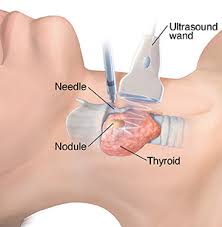A team of experts has developed new clinical guidelines that will help with unnecessary thyroid biopsy to contain the problem. Nodules are extremely common in the thyroid gland and are an abnormality detected by ultrasound. At least two-thirds of adults have nodules in this gland, most of them are benign, or just cancers that cause slow growth, without any threat in life.
“If your cancer doesn’t hurt you and you don’t know it, is it useful to have fine needle aspiration?” said Franklin Tessler of the University of Alabama at Birmingham. “People are asking, what are we doing? Are we using scarce resources wisely?” Thyroid cancer is greatly over-diagnosed in the United States. If the nodule is left alone and the needle is not biopsied, approximately three-quarters of women with thyroid cancer and nearly half of men with thyroid cancer do not cause symptoms or death.
'Each option is a point value ranging from 0 to 3 points. For example, "higher than the height" is 0 points, and "higher than the width" is 3 points.
Tessler and a National Committee of Experts issued guidelines for an ultrasound-based risk stratification system to identify nodules that require biopsy or
ultrasound follow-up. They write that these guidelines "are designed to identify most clinically important malignancies while reducing the number of biopsies performed on benign nodules." "This could have a huge impact on public health," Tesler said. .
Their thyroid imaging, reporting and data systems or TI-RADS mimic the BI-RADS of the American College of Radiology, a widely accepted risk stratification system for breast lesions.
Guidelines sought by experts
1) Establish ultrasound features defined in their previously published dictionaries;
2) Easy to apply in a wide range of ultrasonic practices
3) Ability to classify all thyroid nodules
4) Based on evidence, with the most basic data of 3,800 nodules and more than 100,000 cancers. Their new guidelines have made many attempts over the past 15 years to develop guidelines for fine needle biopsy. Most are based on the details of the appearance and size of the nodules visualized using
high resolution ultrasound.
However, "the excessive, complex and lack of consistency of these systems limits their adoption by the ultrasound community and spurs our efforts to publish classification systems under the auspices of the American College of Radiology," Tessler and colleagues wrote.
The American College of Radiology TI-RADS has five different types of nodular appearance - composition, echo, shape, edge and echo stove. There are two options for shape categories - width is greater than height rather than width. The other four categories each have four choices, such as “low echo” under the echo category or “leafed or irregular” under the margin.
As the authors explain, “Scores are given for all ultrasound features in the nodule, and more suspicious features are awarded additional scores. When evaluating nodules, the reader selects one feature from the first four categories and applies all features. The scores are summarized from the final category. The total number of points determines the ACR TI-RADS level of the nodules, ranging from TR1, benign to TR5, highly suspected of malignancy.
If the sum is 0, the nodule is TR1 and the guidelines recommend no fine needle aspiration or follow-up. If the sum is 2 points, the nodule is TR2, or “unquestionable”, and the guidelines recommend not to perform fine needle aspiration or follow-up. The sum of 3 points is TR3, or "a bit suspicious." For these nodules, if the nodule is 2.5 cm or larger, or about 1 inch or larger, the guide recommends fine needle puncture, and if it is 1.5 cm or larger, they recommend subsequent ultrasound.
The TR4 nodule or "moderate suspicious" is 4 to 6 points, and the TR5 nodule or "highly suspicious" is 7 points or more. For the TR4 nodule, the guidelines recommend fine needle aspiration if the nodule is 1.5 cm or larger, and follow-up if the nodule is 1 cm or larger. For the TR5 nodule, the guidelines recommend fine needle aspiration if the nodule is 1 cm or larger, and follow-up if the nodule is 0.5 cm or larger.
The guidelines recommend limiting fine needle aspiration to each patient's two nodules because the patient is poorly tolerant to three or more nodules, the third biopsy adds cost, with few additional benefits and some extra risks of. The guidelines also recommend appropriate follow-up ultrasound timing. “ACR TI-RADS is designed to balance the benefits of identifying clinically important cancers, as well as the risks and costs of biopsy and treatment for patients with benign nodules or lazy cancer,” the authors write.





 Price is 8-20% Lower Than Other
Price is 8-20% Lower Than Other






